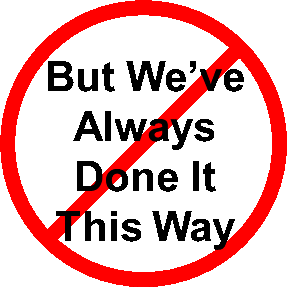 The attributes used to describe people number in the tens of thousands. So too are the ways that people can succeed and fail. Unlike math, there are few absolutes when it comes to the competencies required to be successful. Yet there is one attribute that regularly shows up at the top of the list of successful people – the willingness and ability to challenge the status quo.
The attributes used to describe people number in the tens of thousands. So too are the ways that people can succeed and fail. Unlike math, there are few absolutes when it comes to the competencies required to be successful. Yet there is one attribute that regularly shows up at the top of the list of successful people – the willingness and ability to challenge the status quo.
People who challenge the status quo aren’t content with how things are currently done. Rather than maintain existing approaches, they look for opportunities to improve them. Rather than plan to do things next year like this year, or marginally better, they plan to do things significantly better. Rather than continue along the well-worn path of contemporary norms, they go off-path. They disrupt conventional wisdom. They continually find new ways to add value to their organizations. They work “on the business” rather than merely work “in the business”.
The impact of people who strive to continually improve their organizations can’t be overstated. They are often responsible for creating new sources of revenue through their influence on new offers, products, services, markets, and channels. They are responsible for increasing efficiencies through changes in methods, systems, tools, and skills. They shape organizational culture by setting new examples, fostering innovation, and challenging historical norms. Organizations who lead their industries and enjoy the highest levels of competitive differentiation do so because of those who made substantive improvements, not because of those who merely maintained the status quo.
However, not all is copacetic when working with disrupters of the status quo, aka trailblazers, game changers, and strategic thinkers. With frequent disruption comes frustration and conflict. Change is hard. If not done well or done too frequently, people become fatigued. Even though most people know the danger of becoming complacent, complacency is a comfortable and alluring place. People don’t like to be nudged out of their comfort zone. Change also comes with risk. Not all new programs, offerings, channels, markets, and methods succeed. In fact, many fail. Being a trailblazer, or working with one, is not for sissies.
Do you generally maintain the status quo or are you more likely to challenge it? Do you tend to do things as you always have or do you regularly make improvements to them? Do you normally leave things as they are or do you make frequent changes? Here are a few questions to ask yourself and your team to see how much of a trailblazer you are:
- Open-mindedness: How open-minded are you to new ideas? Are you quick to dismiss new approaches or do you encourage and seek them?
- Curiosity: Are you curious about how things work or could be improved? Do you regularly ask questions like “why do we do that?” or “what would happen if ….?”
- Definition of Good: Do you consider “good” to be good enough? Or do you strive for excellence if not perfection?
- Energy: Do you have the energy and vitality to keep learning, growing, and changing? Do you prefer comfort or do you strive to improve what you do and how you do it?
- Interest in Strategy: Do you primarily focus on the tactical day-to-day activities? Or do you regularly think about and improve the strategies that drive the tactical day-to-day activities?
- Big-Picture Perspective: Do you think about the impact of your decisions on others and other elements of your organizational ecosystem? Do you think about the long-term as well as the short term?
- External Perspective: Do you primarily think about how actions, changes, offerings, and approaches impact internal stakeholders and operations? Or do you think first about how they affect clients, suppliers, and partners?
If you are open minded, curious, perfectionistic, energetic, strategic, big-picture oriented, and externally focused, you are probably a trailblazer. You regularly challenge the status quo. You are probably responsible for many organizational improvements …. As well as frustrations. Yet, if you don’t possess most of these qualities, be wary. Maintaining the status quo in a world of fast-paced change leads to irrelevance and obsolescence. There is a vast landscape of failed companies because they didn’t change when they should have. Of course not everything always needs to be changed. There are times to harvest as well, but look out for complacency. It is riskier than being a trailblazer. If you don’t lead change, you will soon be following someone else’s change. Change is inevitable.
